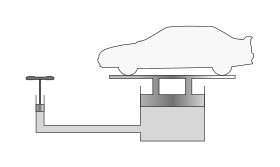
| Part of a series on |
| Continuum mechanics |
|---|
Pascal's law (also Pascal's principle[1][2][3] or the principle of transmission of fluid-pressure) is a principle in fluid mechanics given by Blaise Pascal that states that a pressure change at any point in a confined incompressible fluid is transmitted throughout the fluid such that the same change occurs everywhere.[4] The law was established by French mathematician Blaise Pascal in 1653 and published in 1663.[5][6]
- ^ "Pascal's principle - Definition, Example, & Facts". britannica.com. Archived from the original on 2 June 2015. Retrieved 9 May 2018.
- ^ "Pascal's Principle and Hydraulics". www.grc.nasa.gov. Archived from the original on 5 April 2018. Retrieved 9 May 2018.
- ^ "Pressure". hyperphysics.phy-astr.gsu.edu. Archived from the original on 28 October 2017. Retrieved 9 May 2018.
- ^ Bloomfield, Louis. (2006). How Things Work: The Physics of Everyday Life (Third ed.). John Wiley & Sons. p. 153. ISBN 0-471-46886-X.
- ^ Blaise Pascal, Traitez de l'Equilibre des Liqueurs (Treatise on the Equilibrium of Fluids), Paris, 1663.
- ^ O'Connor, John J.; Robertson, Edmund F., "Pascal's law", MacTutor History of Mathematics Archive, University of St Andrews
